Home / Electrophilic Aromatic Substitution: Introduction
Reactions of Aromatic Molecules
Electrophilic Aromatic Substitution: Introduction
Last updated: September 25th, 2022 |
The Six Key Electrophilic Aromatic Substitution Reactions
- In electrophilic aromatic substitution a C-H bond is broken and a new C-E bond (E being an electrophilic atom such as Cl, Br, N…) is formed.
- There are six key electrophilic aromatic substitution reactions in most introductory organic chemistry courses: chlorination, bromination, nitration, sulfonation, Friedel-Crafts alkylation, and Friedel-Crafts acylation.
- Each of these reactions requires an acid catalyst to activate it so that the relatively unreactive aromatic ring will attack it.
- Alkenes Give “Addition” Products Upon Reaction With Electrophiles. So How Does Benzene Compare?
- Electrophilic Aromatic Substitution
- Lewis Acids Accelerate The Rate of Electrophilic Aromatic Substitution Reactions
- The Key Pattern For Six Important Electrophilic Aromatic Substitution Reactions
- Aromatic Chlorination and Bromination
- Aromatic Nitration and Sulfonation
- Friedel-Crafts Alkylation and Acylation
- Summary: The Six Key Electrophilic Aromatic Substitution Reactions
- Quiz Yourself!
1. Alkenes Give “Addition” Products Upon Reaction With Electrophiles. So How Does Benzene Compare?
When we covered the reactions of alkenes a while back – a lot of reactions! – we saw that the vast majority fell into the class of reactions we call addition reactions. That’s where we break a (relatively weak) C-C (pi) bond and form two new single bonds to carbon. Chlorination of alkenes with Cl2 is a classic example:
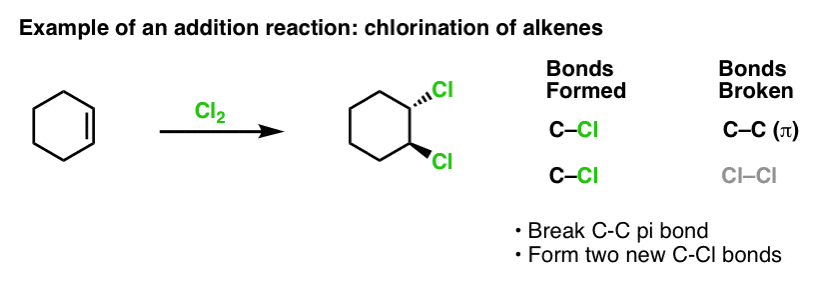
Since we’re on the topic of benzene, it’s natural to wonder how well the pi bonds in aromatic systems (like benzene) compare in reactivity to the pi bonds in alkenes, and by extension, how the reactions of aromatic compounds compare to the reactions of alkenes.
We’ve seen that benzene has unusual stability (36 kcal/mol of resonance energy) relative to what we’d expect for theoretical “cyclohexatriene”, which would certainly lead us to predict that the pi bonds in aromatic molecules will be less reactive, relative to alkenes.
You might also recall that benzene itself is unusually difficult to hydrogenate. Hydrogen (H2) can be made to add across most alkenes in the presence of a catalytic amount of finely divided palladium on carbon (Pd/C), but you really need to break out the can of Aldrich Brand Whup-Ass® (i.e. high temperatures, high pressures of H2 , extended reaction times ) in order to successfully add H2 to benzene, relative to “typical” alkenes.
Knowing this, how might we expect electrophiles like Cl2 or Br2 to react with aromatic compounds like benzene?
2. Electrophilic Aromatic Substitution
Our first guess might be that benzene reacts with Cl2 to give an “addition” product like that shown below (albeit more slowly than with a “normal” alkene):

That’s actually not the product that we observe!
Instead, if you treat benzene with Cl2 you will eventually (and very slowly) obtain the following product: chlorobenzene.

What bonds formed and what bonds broke in this reaction?
We formed C-Cl and broke C-H . Since the pi bonds are all intact, this is not an addition reaction. Instead, this is therefore a type of substitution reaction, where we form and break a bond on a single carbon.
We’ve seen an example of substitution reactions before, but those were nucleophilic substitutions, where a nucleophile (e.g. RS– ) is added to an alkyl halide electrophile (e.g. R-Br), displacing a leaving group (Br– here) forming a C-Nuc bond (C-S in this case) and breaking a C-LG bond (C-Br here).
So is the reaction of Cl2 with benzene likewise a nucleophilic substitution reaction? No!
Cl2 is an extremely poor nucleophile, reacting as an electron-donor only with strong Lewis acids (e.g. AlCl3, below). When combined with even a relatively mild nucleophile such as the pi-bond in an alkene, it behaves as an electrophile (electron acceptor) as we saw in its reaction with alkenes.
The reaction of Cl2 with benzene is thus called an electrophilic aromatic substitution (EAS for short):
- Electrophilic, because we’re adding an electron-poor species (electrophile),
- to an aromatic compound (benzene);
- substitution, because we’re breaking C-H and forming C-E, where E is our electrophile (Cl in this case).
3. Lewis Acids Accelerate The Rate of Electrophilic Aromatic Substitution Reactions
The reaction of Cl2 with benzene is faster than toenail growth, but not by much [ref] (It is, however, much faster with more electron-rich aromatics such as toluene and phenol). So instead of sitting around the lab for weeks waiting for a reaction to complete, we can add a reagent that “soups up” the reactivity of Cl2 to make it into an even better electrophile: a catalyst, in other words.
Addition of a good Lewis acid like AlCl3 or FeCl3 does the trick. [There are many other Lewis acids which will also do the job, but that’s a topic for when we get into the mechanism – not today]. update: see post on mechanism
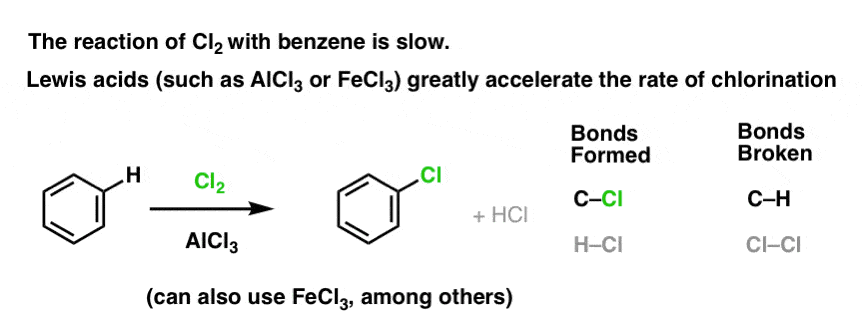
How does this work?
From our series on alcohols you may recall that alcohols (R–OH) can be coaxed to participate in substitution and elimination reactions if a strong acid is added ( forming R–OH2+ ). That’s because the conjugate acid is always a better leaving group ; H2O is a weaker base, and thus a much better leaving group, than HO– . Ethanol itself will never react with NaCl to give ethyl chloride, because the resulting leaving group HO- is too strong a base relative to Cl- for the reaction to proceed to any extent. But if we convert the alcohol into its conjugate acid R-OH2 + with a strong acid such as HCl, the reaction can then proceed, since Cl– is displacing the much weaker base H2O.
It’s can be helpful to think of H+ as weakening the C-O bond, and thus making the carbon attached to it a better electrophile.
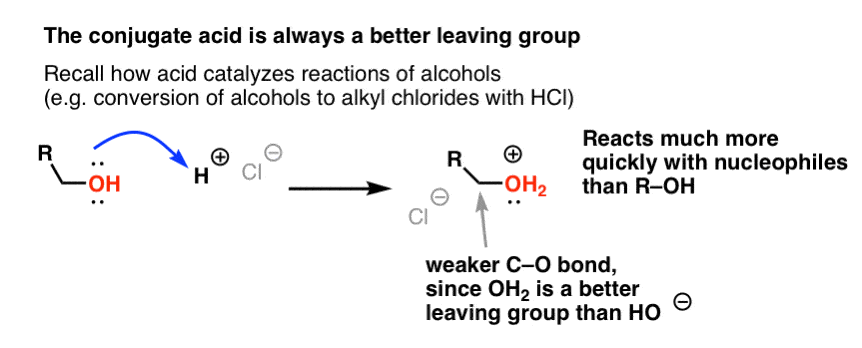
Just as acid “primes” the carbon attached to the OH group for a subsequent reaction by converting the hydroxyl group into its conjugate acid, Lewis acids similarly work the same magic on Cl2 (and for that matter, all the electrophilic aromatic substitution reactions we’ll be covering will involve some kind of acid catalysis).
In the case of chlorination, the Lewis acid (AlCl3, below) accepts a pair of electrons from Cl2. This weakens the Cl–Cl bond, making it into an even better electrophile. Attack by a nucleophile at the distal Cl will liberate not Cl- , but the even weaker base (and thus, better leaving group) AlCl4(-).

Addition of a Lewis acid (which, recall, includes Brønsted acids like H2SO4 ) is a common thread in the six key electrophilic aromatic substitutions which are generally covered in introductory organic chemistry.
4. The Key Pattern For Six Important Electrophilic Aromatic Substitution Reactions
In this section, we’ll introduce these six key electrophilic aromatic substitution reactions, which group nicely into three pairs:
- chlorination and bromination
- nitration and sulfonylation
- Friedel-Crafts alkylation and Friedel-Crafts acylation
We’re not going to get into the mechanisms yet. The point here is just to follow what bonds form and break, so that you see the key pattern.
Here it is:
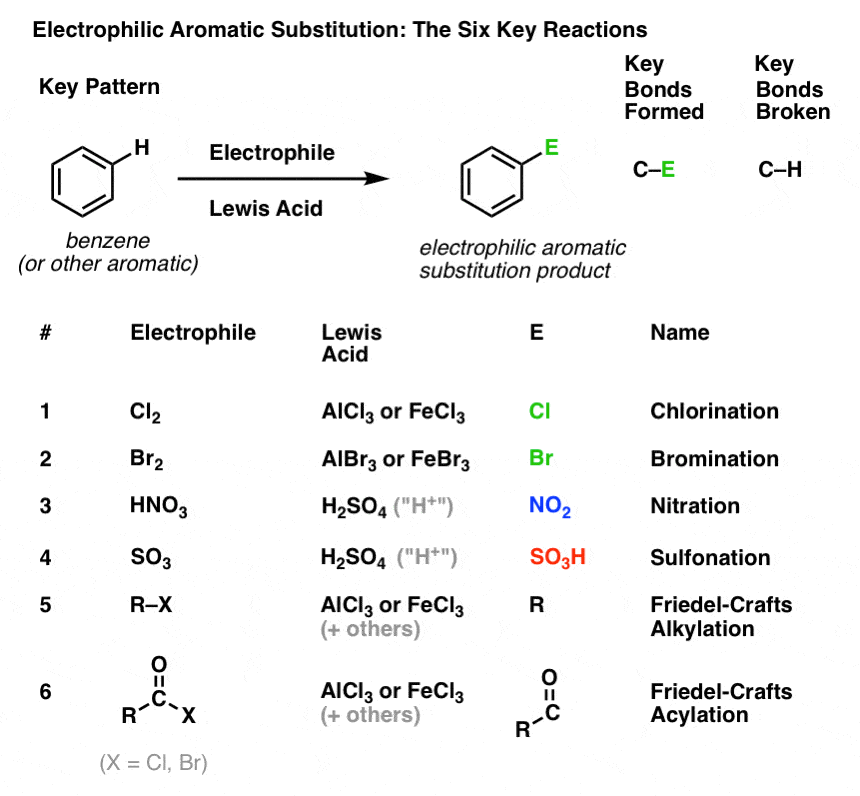
5. Chlorination and Bromination Of Aromatic Molecules
We’ve seen chlorination (above); bromination is very similar. Since Br2 by itself is not a strong enough electrophile to react with benzene at a reasonable rate, we use a Lewis acid such as AlBr3 or FeBr3 to accelerate the reaction. [Using AlBr3/FeBr3 instead of AlCl3/ FeCl3 avoids some “scrambling” of the halides, as we’ll see in a subsequent post when we get into the mechanism].

6. Nitration and Sulfonation of Aromatic Molecules
Nitration (replacement of H with a NO2 group) is not a reaction we saw in our section on alkenes, but it’s a popular reaction with aromatic molecules such as benzene. This is the reaction by which methylbenzene (toluene) is converted to 2,4,6-trinitrotoluene. You’re likely more familiar with this molecule as the high explosive TNT.
Nitration is the substitution of H with NO2, using nitric acid (HNO3) as the source of NO2 and sulphuric acid (H2SO4) as the Lewis acid:

Sulfonation (replacement of H with a SO3H group) also turns out to be a useful reaction. It can be performed by adding sulfur trioxide (SO3) in the presence of sulphuric acid (H2SO4) as the Lewis acid:

7. Friedel-Crafts Alkylation and Acylation
In the four reactions above, we observed the formation of C-Cl, C-Br, C-N and C-S.
It’s also possible to form carbon-carbon bonds to aromatic molecules by adding alkyl or acyl halides in the presence of Lewis acids. These reactions are known as Friedel-Crafts reactions, after their inventors (the reaction dates back to 1877).
In Friedel-Crafts Alkylation, we start with an alkyl halide “R-X” such as CH3CH2Cl and then add a Lewis acid such as AlCl3 or FeCl3 [there are many other Lewis acids which work, but those are the most common examples]. As with Cl2, the Lewis acid accelerates the reaction by coordinating to the halogen, weakening the C–Cl bond, and making it a better leaving group and thus allowing the attached carbon to be more easily attacked by nucleophiles. No reaction occurs without the Lewis acid.
Note that here we form C–C and break C–H.

The Friedel-Crafts Acylation is similar, but we start with an acyl halide. Addition of our Lewis acid results in the formation of C–C and breakage of C–H.

8. Summary: The Six Key Electrophilic Aromatic Substitution Reactions
We’ve shown six key electrophilic aromatic substitution reactions (chlorination, bromination, nitration, sulfonylation, and the Friedel-Crafts alkylation and acylation) and that they all involve the breakage of C-H and the formation of C-E (where “E” is the electrophile in question).
But knowing the bonds that form and break is just the beginning.
Here’s some questions we’d like to know the answer to:
- How do substituents on benzene affect this reaction? For example, how might these reactions be affected if we performed them on methylbenzene? or phenol? or chlorobenzene?
- How do electron-donating or electron-withdrawing substituents affect the rate of the reaction?
- With benzene, only one mono-substituted product can possibly be formed. But what if we start with a mono-substituted product and do an electrophilic aromatic substitution on it? Where do the substituents end up?
- How does the reaction work? How do we explain the formation of C-E and the breakage of C-H ?
- What about other aromatic groups (beyond benzene). How do electrophilic aromatic substitution reactions on pyrrole, pyridine, naphthalene, or other groups compare?
In the next post, we’ll discuss the first question: the effect of electron-donating and electron-withdrawing substituents. We’ll talk about activating and deactivating groups.
Next Post: Activating and Deactivating Groups
Thanks for reading!
Many thanks to Matthew Knowe for assistance with this post.
Notes
Related Articles
- Electrophilic Aromatic Substitutions (1) – Halogenation of Benzene
- Electrophilic Aromatic Substitutions (2) – Nitration and Sulfonation
- EAS Reactions (3) – Friedel-Crafts Acylation and Friedel-Crafts Alkylation
- Electrophilic Aromatic Substitution – The Mechanism
- Understanding Ortho, Para, and Meta Directors
- Why are halogens ortho- para- directors?
- Aromatic Reactions and Synthesis Practice
Quiz Yourself!
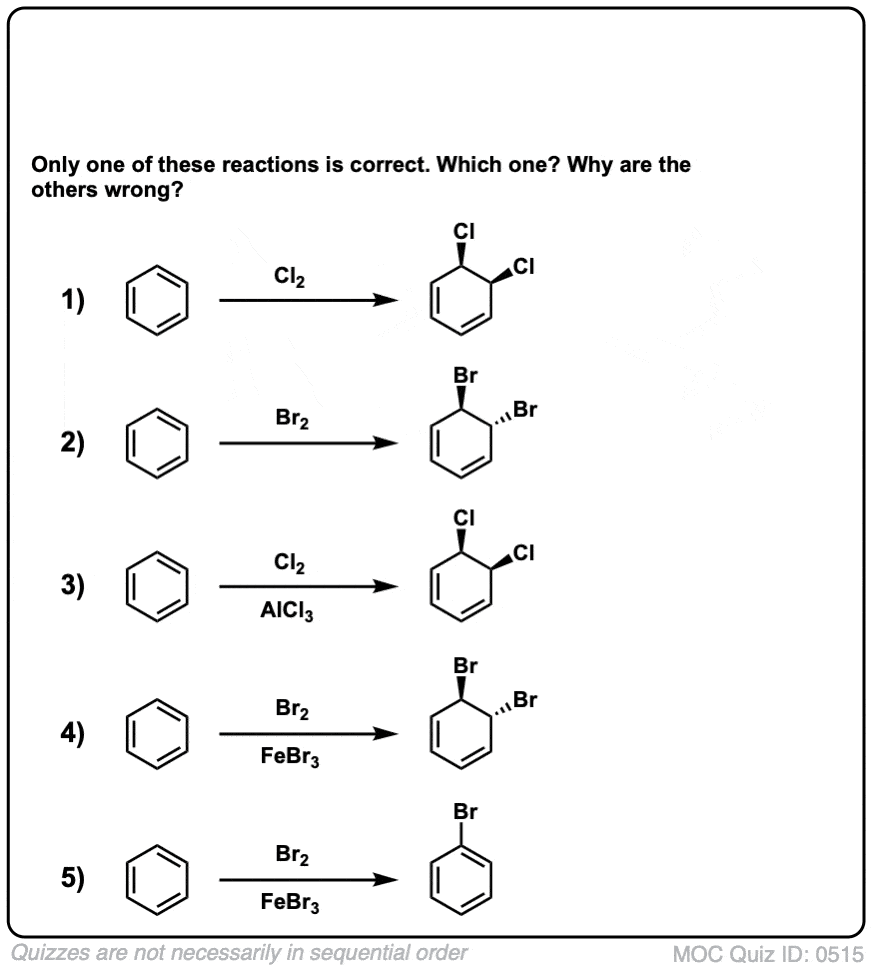 Click to Flip
Click to Flip

 Click to Flip
Click to Flip
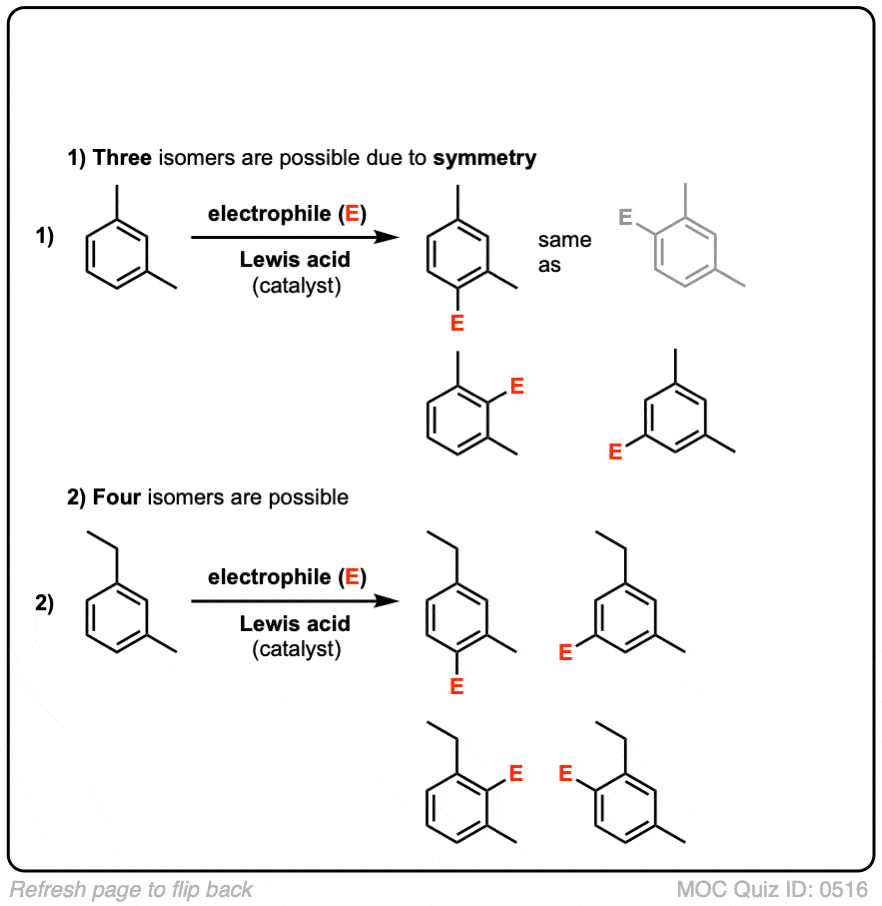
 Click to Flip
Click to Flip
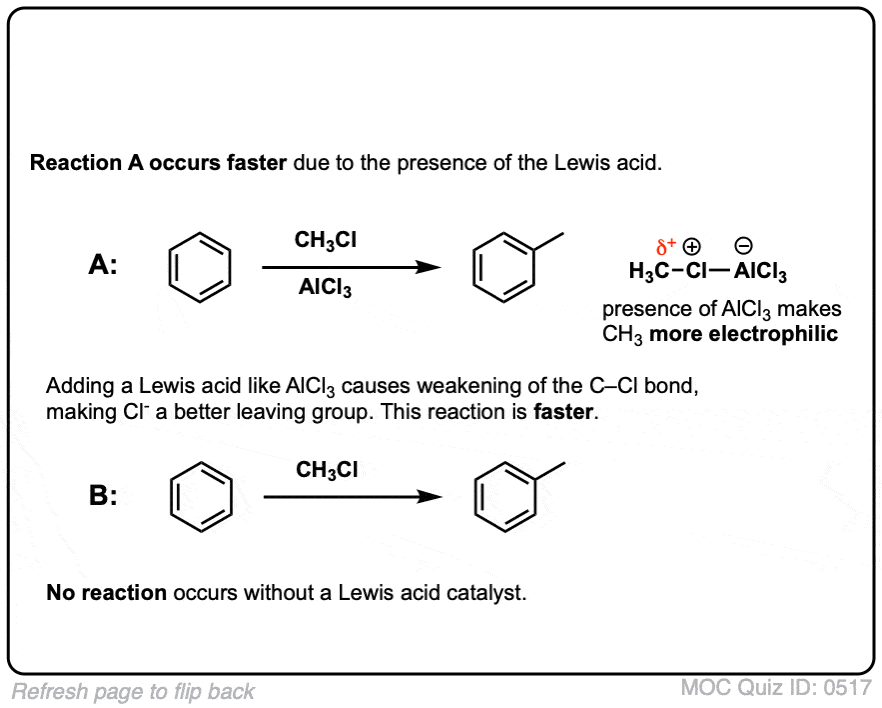
00 General Chemistry Review
01 Bonding, Structure, and Resonance
- How Do We Know Methane (CH4) Is Tetrahedral?
- Hybrid Orbitals and Hybridization
- How To Determine Hybridization: A Shortcut
- Orbital Hybridization And Bond Strengths
- Sigma bonds come in six varieties: Pi bonds come in one
- A Key Skill: How to Calculate Formal Charge
- The Four Intermolecular Forces and How They Affect Boiling Points
- 3 Trends That Affect Boiling Points
- How To Use Electronegativity To Determine Electron Density (and why NOT to trust formal charge)
- Introduction to Resonance
- How To Use Curved Arrows To Interchange Resonance Forms
- Evaluating Resonance Forms (1) - The Rule of Least Charges
- How To Find The Best Resonance Structure By Applying Electronegativity
- Evaluating Resonance Structures With Negative Charges
- Evaluating Resonance Structures With Positive Charge
- Exploring Resonance: Pi-Donation
- Exploring Resonance: Pi-acceptors
- In Summary: Evaluating Resonance Structures
- Drawing Resonance Structures: 3 Common Mistakes To Avoid
- How to apply electronegativity and resonance to understand reactivity
- Bond Hybridization Practice
- Structure and Bonding Practice Quizzes
- Resonance Structures Practice
02 Acid Base Reactions
- Introduction to Acid-Base Reactions
- Acid Base Reactions In Organic Chemistry
- The Stronger The Acid, The Weaker The Conjugate Base
- Walkthrough of Acid-Base Reactions (3) - Acidity Trends
- Five Key Factors That Influence Acidity
- Acid-Base Reactions: Introducing Ka and pKa
- How to Use a pKa Table
- The pKa Table Is Your Friend
- A Handy Rule of Thumb for Acid-Base Reactions
- Acid Base Reactions Are Fast
- pKa Values Span 60 Orders Of Magnitude
- How Protonation and Deprotonation Affect Reactivity
- Acid Base Practice Problems
03 Alkanes and Nomenclature
- Meet the (Most Important) Functional Groups
- Condensed Formulas: Deciphering What the Brackets Mean
- Hidden Hydrogens, Hidden Lone Pairs, Hidden Counterions
- Don't Be Futyl, Learn The Butyls
- Primary, Secondary, Tertiary, Quaternary In Organic Chemistry
- Branching, and Its Affect On Melting and Boiling Points
- The Many, Many Ways of Drawing Butane
- Wedge And Dash Convention For Tetrahedral Carbon
- Common Mistakes in Organic Chemistry: Pentavalent Carbon
- Table of Functional Group Priorities for Nomenclature
- Summary Sheet - Alkane Nomenclature
- Organic Chemistry IUPAC Nomenclature Demystified With A Simple Puzzle Piece Approach
- Boiling Point Quizzes
- Organic Chemistry Nomenclature Quizzes
04 Conformations and Cycloalkanes
- Staggered vs Eclipsed Conformations of Ethane
- Conformational Isomers of Propane
- Newman Projection of Butane (and Gauche Conformation)
- Introduction to Cycloalkanes
- Geometric Isomers In Small Rings: Cis And Trans Cycloalkanes
- Calculation of Ring Strain In Cycloalkanes
- Cycloalkanes - Ring Strain In Cyclopropane And Cyclobutane
- Cyclohexane Conformations
- Cyclohexane Chair Conformation: An Aerial Tour
- How To Draw The Cyclohexane Chair Conformation
- The Cyclohexane Chair Flip
- The Cyclohexane Chair Flip - Energy Diagram
- Substituted Cyclohexanes - Axial vs Equatorial
- Ranking The Bulkiness Of Substituents On Cyclohexanes: "A-Values"
- Cyclohexane Chair Conformation Stability: Which One Is Lower Energy?
- Fused Rings - Cis-Decalin and Trans-Decalin
- Naming Bicyclic Compounds - Fused, Bridged, and Spiro
- Bredt's Rule (And Summary of Cycloalkanes)
- Newman Projection Practice
- Cycloalkanes Practice Problems
05 A Primer On Organic Reactions
- The Most Important Question To Ask When Learning a New Reaction
- Learning New Reactions: How Do The Electrons Move?
- The Third Most Important Question to Ask When Learning A New Reaction
- 7 Factors that stabilize negative charge in organic chemistry
- 7 Factors That Stabilize Positive Charge in Organic Chemistry
- Nucleophiles and Electrophiles
- Curved Arrows (for reactions)
- Curved Arrows (2): Initial Tails and Final Heads
- Nucleophilicity vs. Basicity
- The Three Classes of Nucleophiles
- What Makes A Good Nucleophile?
- What makes a good leaving group?
- 3 Factors That Stabilize Carbocations
- Equilibrium and Energy Relationships
- What's a Transition State?
- Hammond's Postulate
- Learning Organic Chemistry Reactions: A Checklist (PDF)
- Introduction to Free Radical Substitution Reactions
- Introduction to Oxidative Cleavage Reactions
06 Free Radical Reactions
- Bond Dissociation Energies = Homolytic Cleavage
- Free Radical Reactions
- 3 Factors That Stabilize Free Radicals
- What Factors Destabilize Free Radicals?
- Bond Strengths And Radical Stability
- Free Radical Initiation: Why Is "Light" Or "Heat" Required?
- Initiation, Propagation, Termination
- Monochlorination Products Of Propane, Pentane, And Other Alkanes
- Selectivity In Free Radical Reactions
- Selectivity in Free Radical Reactions: Bromination vs. Chlorination
- Halogenation At Tiffany's
- Allylic Bromination
- Bonus Topic: Allylic Rearrangements
- In Summary: Free Radicals
- Synthesis (2) - Reactions of Alkanes
- Free Radicals Practice Quizzes
07 Stereochemistry and Chirality
- Types of Isomers: Constitutional Isomers, Stereoisomers, Enantiomers, and Diastereomers
- How To Draw The Enantiomer Of A Chiral Molecule
- How To Draw A Bond Rotation
- Introduction to Assigning (R) and (S): The Cahn-Ingold-Prelog Rules
- Assigning Cahn-Ingold-Prelog (CIP) Priorities (2) - The Method of Dots
- Enantiomers vs Diastereomers vs The Same? Two Methods For Solving Problems
- Assigning R/S To Newman Projections (And Converting Newman To Line Diagrams)
- How To Determine R and S Configurations On A Fischer Projection
- The Meso Trap
- Optical Rotation, Optical Activity, and Specific Rotation
- Optical Purity and Enantiomeric Excess
- What's a Racemic Mixture?
- Chiral Allenes And Chiral Axes
- Stereochemistry Practice Problems and Quizzes
08 Substitution Reactions
- Nucleophilic Substitution Reactions - Introduction
- Two Types of Nucleophilic Substitution Reactions
- The SN2 Mechanism
- Why the SN2 Reaction Is Powerful
- The SN1 Mechanism
- The Conjugate Acid Is A Better Leaving Group
- Comparing the SN1 and SN2 Reactions
- Polar Protic? Polar Aprotic? Nonpolar? All About Solvents
- Steric Hindrance is Like a Fat Goalie
- Common Blind Spot: Intramolecular Reactions
- Substitution Practice - SN1
- Substitution Practice - SN2
09 Elimination Reactions
- Elimination Reactions (1): Introduction And The Key Pattern
- Elimination Reactions (2): The Zaitsev Rule
- Elimination Reactions Are Favored By Heat
- Two Elimination Reaction Patterns
- The E1 Reaction
- The E2 Mechanism
- E1 vs E2: Comparing the E1 and E2 Reactions
- Antiperiplanar Relationships: The E2 Reaction and Cyclohexane Rings
- Bulky Bases in Elimination Reactions
- Comparing the E1 vs SN1 Reactions
- Elimination (E1) Reactions With Rearrangements
- E1cB - Elimination (Unimolecular) Conjugate Base
- Elimination (E1) Practice Problems And Solutions
- Elimination (E2) Practice Problems and Solutions
10 Rearrangements
11 SN1/SN2/E1/E2 Decision
- Identifying Where Substitution and Elimination Reactions Happen
- Deciding SN1/SN2/E1/E2 (1) - The Substrate
- Deciding SN1/SN2/E1/E2 (2) - The Nucleophile/Base
- SN1 vs E1 and SN2 vs E2 : The Temperature
- Deciding SN1/SN2/E1/E2 - The Solvent
- Wrapup: The Key Factors For Determining SN1/SN2/E1/E2
- Alkyl Halide Reaction Map And Summary
- SN1 SN2 E1 E2 Practice Problems
12 Alkene Reactions
- E and Z Notation For Alkenes (+ Cis/Trans)
- Alkene Stability
- Alkene Addition Reactions: "Regioselectivity" and "Stereoselectivity" (Syn/Anti)
- Stereoselective and Stereospecific Reactions
- Hydrohalogenation of Alkenes and Markovnikov's Rule
- Hydration of Alkenes With Aqueous Acid
- Rearrangements in Alkene Addition Reactions
- Halogenation of Alkenes and Halohydrin Formation
- Oxymercuration Demercuration of Alkenes
- Hydroboration Oxidation of Alkenes
- m-CPBA (meta-chloroperoxybenzoic acid)
- OsO4 (Osmium Tetroxide) for Dihydroxylation of Alkenes
- Palladium on Carbon (Pd/C) for Catalytic Hydrogenation of Alkenes
- Cyclopropanation of Alkenes
- A Fourth Alkene Addition Pattern - Free Radical Addition
- Alkene Reactions: Ozonolysis
- Summary: Three Key Families Of Alkene Reaction Mechanisms
- Synthesis (4) - Alkene Reaction Map, Including Alkyl Halide Reactions
- Alkene Reactions Practice Problems
13 Alkyne Reactions
- Acetylides from Alkynes, And Substitution Reactions of Acetylides
- Partial Reduction of Alkynes With Lindlar's Catalyst
- Partial Reduction of Alkynes With Na/NH3 To Obtain Trans Alkenes
- Alkyne Hydroboration With "R2BH"
- Hydration and Oxymercuration of Alkynes
- Hydrohalogenation of Alkynes
- Alkyne Halogenation: Bromination, Chlorination, and Iodination of Alkynes
- Alkyne Reactions - The "Concerted" Pathway
- Alkenes To Alkynes Via Halogenation And Elimination Reactions
- Alkynes Are A Blank Canvas
- Synthesis (5) - Reactions of Alkynes
- Alkyne Reactions Practice Problems With Answers
14 Alcohols, Epoxides and Ethers
- Alcohols - Nomenclature and Properties
- Alcohols Can Act As Acids Or Bases (And Why It Matters)
- Alcohols - Acidity and Basicity
- The Williamson Ether Synthesis
- Ethers From Alkenes, Tertiary Alkyl Halides and Alkoxymercuration
- Alcohols To Ethers via Acid Catalysis
- Cleavage Of Ethers With Acid
- Epoxides - The Outlier Of The Ether Family
- Opening of Epoxides With Acid
- Epoxide Ring Opening With Base
- Making Alkyl Halides From Alcohols
- Tosylates And Mesylates
- PBr3 and SOCl2
- Elimination Reactions of Alcohols
- Elimination of Alcohols To Alkenes With POCl3
- Alcohol Oxidation: "Strong" and "Weak" Oxidants
- Demystifying The Mechanisms of Alcohol Oxidations
- Protecting Groups For Alcohols
- Thiols And Thioethers
- Calculating the oxidation state of a carbon
- Oxidation and Reduction in Organic Chemistry
- Oxidation Ladders
- SOCl2 Mechanism For Alcohols To Alkyl Halides: SN2 versus SNi
- Alcohol Reactions Roadmap (PDF)
- Alcohol Reaction Practice Problems
- Epoxide Reaction Quizzes
- Oxidation and Reduction Practice Quizzes
15 Organometallics
- What's An Organometallic?
- Formation of Grignard and Organolithium Reagents
- Organometallics Are Strong Bases
- Reactions of Grignard Reagents
- Protecting Groups In Grignard Reactions
- Synthesis Problems Involving Grignard Reagents
- Grignard Reactions And Synthesis (2)
- Organocuprates (Gilman Reagents): How They're Made
- Gilman Reagents (Organocuprates): What They're Used For
- The Heck, Suzuki, and Olefin Metathesis Reactions (And Why They Don't Belong In Most Introductory Organic Chemistry Courses)
- Reaction Map: Reactions of Organometallics
- Grignard Practice Problems
16 Spectroscopy
- Degrees of Unsaturation (or IHD, Index of Hydrogen Deficiency)
- Conjugation And Color (+ How Bleach Works)
- Introduction To UV-Vis Spectroscopy
- UV-Vis Spectroscopy: Absorbance of Carbonyls
- UV-Vis Spectroscopy: Practice Questions
- Bond Vibrations, Infrared Spectroscopy, and the "Ball and Spring" Model
- Infrared Spectroscopy: A Quick Primer On Interpreting Spectra
- IR Spectroscopy: 4 Practice Problems
- 1H NMR: How Many Signals?
- Homotopic, Enantiotopic, Diastereotopic
- Diastereotopic Protons in 1H NMR Spectroscopy: Examples
- C13 NMR - How Many Signals
- Liquid Gold: Pheromones In Doe Urine
- Natural Product Isolation (1) - Extraction
- Natural Product Isolation (2) - Purification Techniques, An Overview
- Structure Determination Case Study: Deer Tarsal Gland Pheromone
17 Dienes and MO Theory
- What To Expect In Organic Chemistry 2
- Are these molecules conjugated?
- Conjugation And Resonance In Organic Chemistry
- Bonding And Antibonding Pi Orbitals
- Molecular Orbitals of The Allyl Cation, Allyl Radical, and Allyl Anion
- Pi Molecular Orbitals of Butadiene
- Reactions of Dienes: 1,2 and 1,4 Addition
- Thermodynamic and Kinetic Products
- More On 1,2 and 1,4 Additions To Dienes
- s-cis and s-trans
- The Diels-Alder Reaction
- Cyclic Dienes and Dienophiles in the Diels-Alder Reaction
- Stereochemistry of the Diels-Alder Reaction
- Exo vs Endo Products In The Diels Alder: How To Tell Them Apart
- HOMO and LUMO In the Diels Alder Reaction
- Why Are Endo vs Exo Products Favored in the Diels-Alder Reaction?
- Diels-Alder Reaction: Kinetic and Thermodynamic Control
- The Retro Diels-Alder Reaction
- The Intramolecular Diels Alder Reaction
- Regiochemistry In The Diels-Alder Reaction
- The Cope and Claisen Rearrangements
- Electrocyclic Reactions
- Electrocyclic Ring Opening And Closure (2) - Six (or Eight) Pi Electrons
- Diels Alder Practice Problems
- Molecular Orbital Theory Practice
18 Aromaticity
- Introduction To Aromaticity
- Rules For Aromaticity
- Huckel's Rule: What Does 4n+2 Mean?
- Aromatic, Non-Aromatic, or Antiaromatic? Some Practice Problems
- Antiaromatic Compounds and Antiaromaticity
- The Pi Molecular Orbitals of Benzene
- The Pi Molecular Orbitals of Cyclobutadiene
- Frost Circles
- Aromaticity Practice Quizzes
19 Reactions of Aromatic Molecules
- Electrophilic Aromatic Substitution: Introduction
- Activating and Deactivating Groups In Electrophilic Aromatic Substitution
- Electrophilic Aromatic Substitution - The Mechanism
- Ortho-, Para- and Meta- Directors in Electrophilic Aromatic Substitution
- Understanding Ortho, Para, and Meta Directors
- Why are halogens ortho- para- directors?
- Disubstituted Benzenes: The Strongest Electron-Donor "Wins"
- Electrophilic Aromatic Substitutions (1) - Halogenation of Benzene
- Electrophilic Aromatic Substitutions (2) - Nitration and Sulfonation
- EAS Reactions (3) - Friedel-Crafts Acylation and Friedel-Crafts Alkylation
- Intramolecular Friedel-Crafts Reactions
- Nucleophilic Aromatic Substitution (NAS)
- Nucleophilic Aromatic Substitution (2) - The Benzyne Mechanism
- Reactions on the "Benzylic" Carbon: Bromination And Oxidation
- The Wolff-Kishner, Clemmensen, And Other Carbonyl Reductions
- More Reactions on the Aromatic Sidechain: Reduction of Nitro Groups and the Baeyer Villiger
- Aromatic Synthesis (1) - "Order Of Operations"
- Synthesis of Benzene Derivatives (2) - Polarity Reversal
- Aromatic Synthesis (3) - Sulfonyl Blocking Groups
- Birch Reduction
- Synthesis (7): Reaction Map of Benzene and Related Aromatic Compounds
- Aromatic Reactions and Synthesis Practice
- Electrophilic Aromatic Substitution Practice Problems
20 Aldehydes and Ketones
- What's The Alpha Carbon In Carbonyl Compounds?
- Nucleophilic Addition To Carbonyls
- Aldehydes and Ketones: 14 Reactions With The Same Mechanism
- Sodium Borohydride (NaBH4) Reduction of Aldehydes and Ketones
- Grignard Reagents For Addition To Aldehydes and Ketones
- Wittig Reaction
- Hydrates, Hemiacetals, and Acetals
- Imines - Properties, Formation, Reactions, and Mechanisms
- All About Enamines
- Breaking Down Carbonyl Reaction Mechanisms: Reactions of Anionic Nucleophiles (Part 2)
- Aldehydes Ketones Reaction Practice
21 Carboxylic Acid Derivatives
- Nucleophilic Acyl Substitution (With Negatively Charged Nucleophiles)
- Addition-Elimination Mechanisms With Neutral Nucleophiles (Including Acid Catalysis)
- Basic Hydrolysis of Esters - Saponification
- Transesterification
- Proton Transfer
- Fischer Esterification - Carboxylic Acid to Ester Under Acidic Conditions
- Lithium Aluminum Hydride (LiAlH4) For Reduction of Carboxylic Acid Derivatives
- LiAlH[Ot-Bu]3 For The Reduction of Acid Halides To Aldehydes
- Di-isobutyl Aluminum Hydride (DIBAL) For The Partial Reduction of Esters and Nitriles
- Amide Hydrolysis
- Thionyl Chloride (SOCl2)
- Diazomethane (CH2N2)
- Carbonyl Chemistry: Learn Six Mechanisms For the Price Of One
- Making Music With Mechanisms (PADPED)
- Carboxylic Acid Derivatives Practice Questions
22 Enols and Enolates
- Keto-Enol Tautomerism
- Enolates - Formation, Stability, and Simple Reactions
- Kinetic Versus Thermodynamic Enolates
- Aldol Addition and Condensation Reactions
- Reactions of Enols - Acid-Catalyzed Aldol, Halogenation, and Mannich Reactions
- Claisen Condensation and Dieckmann Condensation
- Decarboxylation
- The Malonic Ester and Acetoacetic Ester Synthesis
- The Michael Addition Reaction and Conjugate Addition
- The Robinson Annulation
- Haloform Reaction
- The Hell–Volhard–Zelinsky Reaction
- Enols and Enolates Practice Quizzes
23 Amines
- The Amide Functional Group: Properties, Synthesis, and Nomenclature
- Basicity of Amines And pKaH
- 5 Key Basicity Trends of Amines
- The Mesomeric Effect And Aromatic Amines
- Nucleophilicity of Amines
- Alkylation of Amines (Sucks!)
- Reductive Amination
- The Gabriel Synthesis
- Some Reactions of Azides
- The Hofmann Elimination
- The Hofmann and Curtius Rearrangements
- The Cope Elimination
- Protecting Groups for Amines - Carbamates
- The Strecker Synthesis of Amino Acids
- Introduction to Peptide Synthesis
- Reactions of Diazonium Salts: Sandmeyer and Related Reactions
- Amine Practice Questions
24 Carbohydrates
- D and L Notation For Sugars
- Pyranoses and Furanoses: Ring-Chain Tautomerism In Sugars
- What is Mutarotation?
- Reducing Sugars
- The Big Damn Post Of Carbohydrate-Related Chemistry Definitions
- The Haworth Projection
- Converting a Fischer Projection To A Haworth (And Vice Versa)
- Reactions of Sugars: Glycosylation and Protection
- The Ruff Degradation and Kiliani-Fischer Synthesis
- Isoelectric Points of Amino Acids (and How To Calculate Them)
- Carbohydrates Practice
- Amino Acid Quizzes
25 Fun and Miscellaneous
- A Gallery of Some Interesting Molecules From Nature
- Screw Organic Chemistry, I'm Just Going To Write About Cats
- On Cats, Part 1: Conformations and Configurations
- On Cats, Part 2: Cat Line Diagrams
- On Cats, Part 4: Enantiocats
- On Cats, Part 6: Stereocenters
- Organic Chemistry Is Shit
- The Organic Chemistry Behind "The Pill"
- Maybe they should call them, "Formal Wins" ?
- Why Do Organic Chemists Use Kilocalories?
- The Principle of Least Effort
- Organic Chemistry GIFS - Resonance Forms
- Reproducibility In Organic Chemistry
- What Holds The Nucleus Together?
- How Reactions Are Like Music
- Organic Chemistry and the New MCAT
26 Organic Chemistry Tips and Tricks
- Common Mistakes: Formal Charges Can Mislead
- Partial Charges Give Clues About Electron Flow
- Draw The Ugly Version First
- Organic Chemistry Study Tips: Learn the Trends
- The 8 Types of Arrows In Organic Chemistry, Explained
- Top 10 Skills To Master Before An Organic Chemistry 2 Final
- Common Mistakes with Carbonyls: Carboxylic Acids... Are Acids!
- Planning Organic Synthesis With "Reaction Maps"
- Alkene Addition Pattern #1: The "Carbocation Pathway"
- Alkene Addition Pattern #2: The "Three-Membered Ring" Pathway
- Alkene Addition Pattern #3: The "Concerted" Pathway
- Number Your Carbons!
- The 4 Major Classes of Reactions in Org 1
- How (and why) electrons flow
- Grossman's Rule
- Three Exam Tips
- A 3-Step Method For Thinking Through Synthesis Problems
- Putting It Together
- Putting Diels-Alder Products in Perspective
- The Ups and Downs of Cyclohexanes
- The Most Annoying Exceptions in Org 1 (Part 1)
- The Most Annoying Exceptions in Org 1 (Part 2)
- The Marriage May Be Bad, But the Divorce Still Costs Money
- 9 Nomenclature Conventions To Know
- Nucleophile attacks Electrophile
27 Case Studies of Successful O-Chem Students
- Success Stories: How Corina Got The The "Hard" Professor - And Got An A+ Anyway
- How Helena Aced Organic Chemistry
- From a "Drop" To B+ in Org 2 – How A Hard Working Student Turned It Around
- How Serge Aced Organic Chemistry
- Success Stories: How Zach Aced Organic Chemistry 1
- Success Stories: How Kari Went From C– to B+
- How Esther Bounced Back From a "C" To Get A's In Organic Chemistry 1 And 2
- How Tyrell Got The Highest Grade In Her Organic Chemistry Course
- This Is Why Students Use Flashcards
- Success Stories: How Stu Aced Organic Chemistry
- How John Pulled Up His Organic Chemistry Exam Grades
- Success Stories: How Nathan Aced Organic Chemistry (Without It Taking Over His Life)
- How Chris Aced Org 1 and Org 2
- Interview: How Jay Got an A+ In Organic Chemistry
- How to Do Well in Organic Chemistry: One Student's Advice
- "America's Top TA" Shares His Secrets For Teaching O-Chem
- "Organic Chemistry Is Like..." - A Few Metaphors
- How To Do Well In Organic Chemistry: Advice From A Tutor
- Guest post: "I went from being afraid of tests to actually looking forward to them".
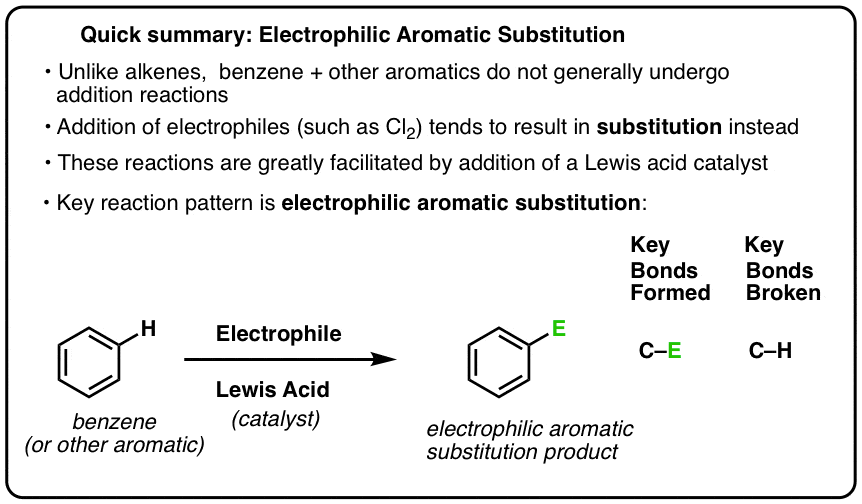
It’s because the molecule lacks a plane of symmetry.
I truly loved the way you explain!!! Thank you continue through…
Hello, I don’t understand how the quiz question on ”How many isomers are formed” lead to the c(ch3)3 substituted benzene having four isomers?
Please also include about addition reactions on multiple aromatic systems like anthracene, biphenyl etc. It will be very much helpful
I have a question. I’m currently working on the project. It consists of getting dicoumarol from coumarine from cinnamon. One step is adding OH group on fourth carbon atom so I can get 4-hydroxycoumarin. I have no idea and I would be so grateful if someone answered me their advices. Please, it’s really urgent. Thank you in advance
Please provide order of electrophilic reaction in different aromatic compounds (benzene and heterocyclic)
That sounds like a good topic for you to research!
Fine but not enough. Disubstituted compounds should be discussed
Covered in a later post!
Just one Suggestion
Plz organize the topics in an order so that the readers can go through them serial wise as it is very difficult for us(students) to search for the next topic and is time consuming as well.
If there’s a provision of that plz accept my apology as I am new to this website.
But the lessons are excellent..!!!! ? The explanation is Nice….
Thank you
Yes – in progress!
Amazing!
“Since Br2 by itself is not a strong enough electrophile to react with benzene at a reasonable rate…” – it is usually true, but the reaction is fast with concentration of Br2 being high (without any catalysts) [JCC 2016, 37, 210–225; DOI: 10.1002/jcc.23985].
Sure – it can happen (especially with electron rich substrates), but generally speaking, you want to use a catalyst.